Financial Statements: Long-Lived Assets
Tan KW
Publish date: Sun, 14 Jul 2013, 07:31 PM
By David Harper
(Contact David)
In the preceding section, we examined working capital, which refers to the current assets andliabilities of a company. In this section, we take a closer look at the long-lived assets (a.k.a. non-current assets) carried on the balance sheet. Long-lived assets are those that provide the company with a future economic benefit beyond the current year or operating period. It may be helpful to remember that most (but not all) long-lived assets start as some sort of purchase by the company.
In fact, whenever a company purchases an asset, it will either expense or capitalize the purchase. Consider a simple example of a company that generates $150 in sales and, in the same year, spends $100 on research and development (R&D). In scenario A below, the entire $100 is expensed and, as a result, the profit is simply $50 ($100 – $50). In scenario B, the company capitalizes the $100, which means a long-lived asset is created on the balance sheet and the cost is allocated (charged) as an expense over future periods. If we assume the asset has a five-year life, only one-fifth of the investment is allocated in the first year. The other $80 remains on the balance sheet, to be allocated as an expense over the subsequent four years. Therefore, the profits are higher under scenario B, although the cash flows in the two scenarios are exactly the same:
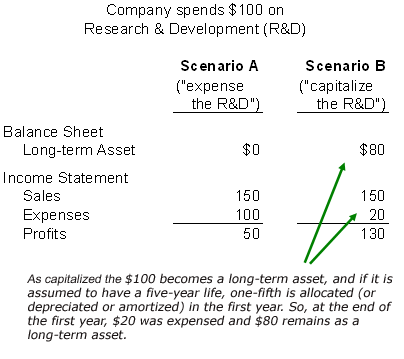 |
There are various technical terms for the allocation of capitalized assets, but each refers to the pattern in which the assets' prices are allocated to future period expenses: depreciation is the allocation of plant, property and equipment; amortization is the allocation of goodwill; depletion is the allocation of natural resource assets, such as oil wells.
The typical long-lived area of the balance sheet includes the following accounts:
| Long-lived asset account: | Usually created because the company purchased: | Allocated to income statement expense (or income) via: |
| Property, plant & equipment | tangible property | depreciation or impairment (i.e. abrupt loss in value) |
| Investments | the securities of another company | gain/Loss or impairment |
| Goodwill | another company, but paid more than fair value (The excess over fair value is goodwill) | amortization or impairment |
Depreciation is tricky because it is the allocation of a prior capital expenditure to an annual expense. Reported profits are directly impacted by the depreciation method. And because depreciation is anon-cash expense charge, some analysts prefer cash flow measures or EBITDA, which is a measure of earnings before the subtraction of depreciation. However, depreciation typically cannot be ignored because it serves a valuable purpose: it sets aside an annual amount (a sinking fund, if you will) for the maintenance and replacement of fixed assets.
Because depreciation is an accounting convention, you sometimes see an alternative label: "economic depreciation." This is an adjusted depreciation that represents the "true" amount that a company needs to allocate annually in order to maintain and replace its fixed asset base. In theory, economic depreciation corrects for errors in both directions. Consider the depreciation of real estate, which is usually an over-charge, reducing the real estate's book value, which is calculated by the original investment minus accumulated depreciation, to something far below its fair market value. On the other hand, consider a key piece of equipment that is subject to rapid inflation. Its eventual replacement will cost more than the original, in which case depreciation actually under-charges the expense. If depreciation expense is large relative to other expenses, it often helps to ask whether the charge approximates the replacement value of the assets. Determining this can be difficult, but sometimes the footnotes in a company's financial documents give explicit clues about future expenditures.
It is also helpful to look at the underlying trend in the fixed asset base. This will tell you whether the company is increasing or decreasing its investment in its fixed asset base. An interesting side effect of decreasing investments in the fixed asset is that it can temporarily boost reported profits. Consider the non-current portion of Motorola's balance sheet:
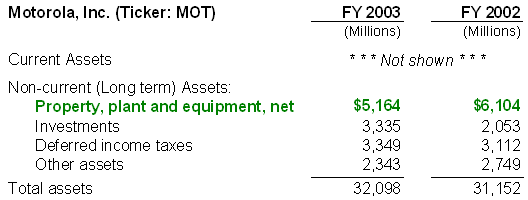 |
You can see that the book value of Motorola's plant, property and equipment (PP&E) fell roughly a billion dollars to $5.164 billion in 2003. We can understand this better by examining two footnotes, which are collected below:
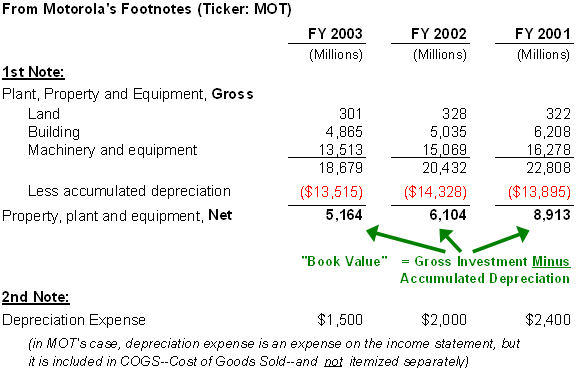 |
The book value is the gross investment (that is, the original or historical purchase price) minus the accumulated depreciation expense. Book value is also called net value, meaning net of depreciation. In Motorola's case, the gross asset value is dropping (which indicates asset dispositions) and so is the book value. Motorola has disposed of assets without a commensurate investment in new assets. Put another way, Motorola's asset base is aging.
Notice the effect on depreciation expense: it drops significantly, from $2 billion to $1.5 billion in 2003. In Motorola's case, depreciation is buried in cost of goods sold (COGS), but the temporary impact is a direct boost in pre-tax profits of half a billion dollars. To summarize, an aging asset base - the result of the company disposing of some old assets but not buying new ones - can temporarily boost profits. When assets are aged to inflate reported profits, it is sometimes called "harvesting the assets."
We can directly estimate the age of the fixed asset base with two measures: average age in percentage terms and average age in years. Average age in percentage equals accumulated depreciation divided by the gross investment. It represents the proportion of the assets that have been depreciated: the closer to 100%, the older the asset base. Average age in years equals accumulated depreciation divided by the annual depreciation expense. It is a rough estimate of the age of the in-place asset base. Below, we calculated each for Motorola. As you can see, these measures show that the asset base is aging.
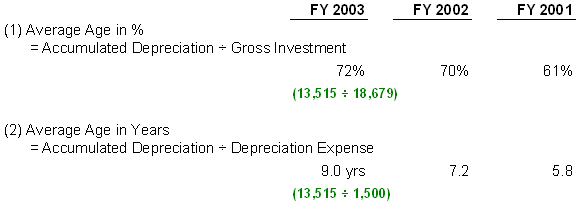 |
Investments
There are various methods to account for corporate investments, and often management has some discretion in selecting a method. When one company (a parent company) controls more than 50% of the shares of another company (a subsidiary), the subsidiary's accounts are consolidated into the parent's. When the control is less than 50%, there are three basic methods for carrying the value of an investment: these are the cost, market and equity methods. We show each method below. But first, keep in mind that there are three sorts of investment returns:
- The investment can appreciate (or depreciate) in market value: we call these holding gains or losses.
- The investment can generate earnings that are not currently distributed to the parent and are instead retained. We call this investment income.
- The investment can distribute some of its income as cash dividends to the parent.
The table below explains the three methods of accounting for corporate investments that are less than 50% owned by the parent:
| Method | Value of Investment on the Balance Sheet | Cash Dividends and Investment Income | When Used |
| Cost | The investment is carried at its historical cost; holding gains/losses are recognized only when the asset is sold. | Only actual (cash) dividends are recognized by the parent. Income is not recognized | The "ready market price" is available or the company intends to hold the investment until sale. |
| Market | The market value of the asset is updated each period, which creates holding period gains and losses. | Cash dividends are recognized; income may or may not be recognized. | The investment is marketable (has a readily available price) and is either used for trading purposes and is "available for sale" by the trading company. |
| Equity Method | The investment is carried at its historical cost; holding gains/losses are recognized only when the asset is sold. | The parent\'s share of income - including any cash dividends received - is recognized. | The parent company has a "significant influence" over the investment. This generally applies when the parent owns 20-50% of the investment. |
When an investment pays cash dividends, the rules are straightforward: they will be recognized on the parent company's income statement. But the rules are not straightforward for undistributed earnings and gains/losses in the investment's holding value. In both cases, the parent may or may not recognize the earnings/gains/losses.
We have at least three goals when examining the investment accounts. First, we want to see if the accounting treatment has hidden some underlying economic gain or loss. For example, if a company uses the cost method on a superior investment that doesn't pay dividends, the investment gains will eventually pay off in a future period. Our second goal is to ask whether investment gains/losses are recurring. Because they are usually not operating assets of the business, we may want to consider them separately from a valuation of the business. The third goal is to gain valuable clues about the company's business strategy by looking at its investments. More often than not, such investments are not solely motivated by financial returns. They are often strategic investments made in current/future business partners. Interesting examples include investments essentially made tooutsource research and development or to tap into different markets.
Let's consider a specific example with the recent long-lived accounts for Texas Instruments:
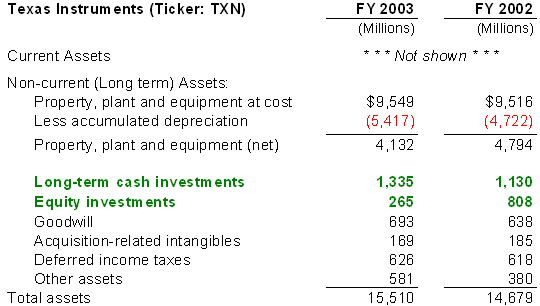 |
What immediately stands out is that equity investments dropped from $800 million to $265 million in 2003. This should encourage us to examine the footnotes to understand why.
The footnotes in the same annual report include the following:
During the third and fourth quarters of 2003, TI sold its remaining 57 million shares of Micron common stock, which were received in connection with TI's sale of its memory business unit to Micron in 1998. TI recognized pretax gains of $203 million from these sales, which were recorded in other income (expense) net….The combined effect of the after-tax gains and the tax benefit was an increase of $355 million to TI's 2003 net income.
We learn two things from this footnote: 1) TI sold its significant stake in Micron, and 2) that sale created a one-time (nonrecurring) boost in current profits of $355 million.
Goodwill
Goodwill is created when one company (the buyer) purchases another company (the target). At the time of purchase, all of the assets and liabilities of the target company are re-appraised to their estimated fair value. This includes even intangible assets that were not formerly carried on the target's balance sheet, such as trademarks, licenses, in-process research & development, and maybe even key relationships. Basically, accountants try to estimate the value of the entire target company, including both tangible and intangible assets. If the buyer happens to pay more than this amount, every extra dollar falls into goodwill. Goodwill is a catch-all account, because there is nowhere else to put it. From the accountant's perspective, it is the amount the buyer "overpays" for the target.
To illustrate, we show a target company below that carries $100 of assets when it is purchased. The assets are marked-to-market (that is, appraised to their fair market value) and they include $40 in intangibles. Further, the target has $20 in liabilities, so the equity is worth $80 ($100 – $20). But the buyer pays $110, which results in a purchase premium of $30. Since we do not know where to assign this excess, a goodwill account of $30 is created. The bottom exhibit shows the target company's accounts, but they will be consolidated into the buyer's accounts so that the buyer carries the goodwill.
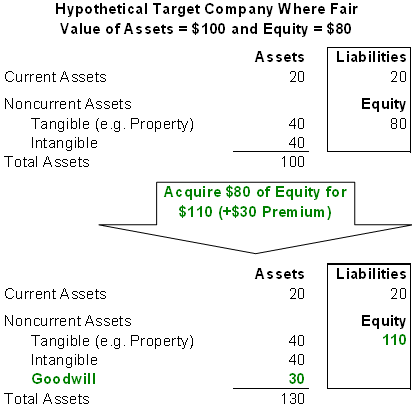 |
At one time, goodwill was amortized like depreciation. But as of 2002, goodwill amortization is no longer permitted. Now, companies must perform an annual test of their goodwill. If the test reveals that the acquisition's value has decreased, then the company must impair, or write-down, the value of the goodwill. This will create an expense, which is often buried in a one-time restructuring cost, and an equivalent decrease in the goodwill account.
The idea behind this change was the assumption that as an unidentified intangible, goodwill does not necessarily depreciate automatically like plants or machinery. This is arguably an improvement in accounting methods because we can watch for goodwill impairments, which are sometimes significant red flags. Because the value of the acquisition is typically based on a discounted cash flow analysis, the company is basically telling you "we took another look at the projections for the acquired business, and they are not as good as we thought last year."
Consider Novell's latest balance sheet:
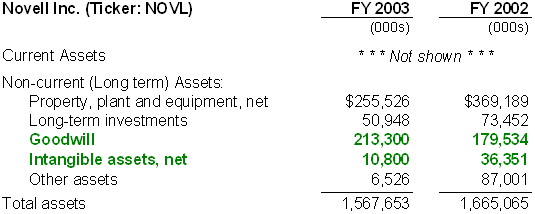 |
We see that intangible assets decreased from $36.351 million to $10.8 million. Because purchases anddispositions impact the accounts, it is not enough to check increases or decreases. For example, Novell's goodwill increased, but that could be due to a purchase. Similarly, it is possible that the decrease in intangible assets could be the result of a disposition, but this is unlikely as it is difficult to sell an intangible by itself.
A careful look at the footnote explains that most of this intangible asset decline was due to impairment. That is, a previously acquired technology has not generated the revenues that were originally expected:
During the third quarter of fiscal 2003, we determined that impairment indicators existed related to the developed technology and trade names we acquired from SilverStream as a result of unexpected revenue declines and the evident failure to achieve revenue growth targets for the exteNd products. Based on an independent valuation of these assets, we recorded a $23.6 million charge to cost of revenue to write down these assets to estimated fair value, which was determined by the net present value of future estimated revenue streams attributed to these assets.
Summary
You have to be careful when you examine the long-lived assets. It is hard to make isolated judgments about the quality of investments solely by looking at measures such as R&D as a percentage or capital expenditures as a percentage of sales. Even useful ratios such as ROE and ROA are highly dependent on the particular accounting methods employed. For example, both of these ratios count assets at book value, so they depend on the depreciation method.
You can, however, look for trends and clues such as the following:
- The method of depreciation and the pattern of investment - Is the company maintaining investment(s)? If investments are declining and assets are aging, are profits distorted?
- The specific nature and performance of investments - Have investment sales created one-time gains?
- Goodwill impairments - Has goodwill been impaired, and what is the business implication going forward?
http://www.investopedia.com/university/financialstatements/financialstatements7.asp


















